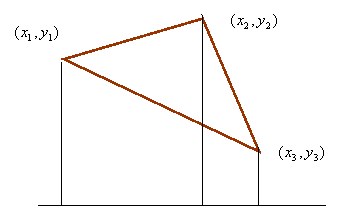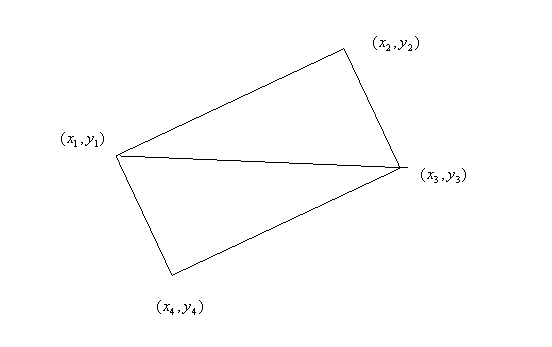Determinants: (lesson 2 of 2)
Applications of Determinants
Cramer's rule:
For linear system
An×nx=b, if
det(A)=0, then the system has the unique solution,
x1=det(A)det(A1),x2=det(A)det(A2),...,xn=det(A)det(An)
where
Ai, i=1,2,...,n, is the matrix obtained
by replacing the i-th column of A by b.
Example 1:
Solve the
following system of linear equations using the Cramer's rule,
x1+3x2+x3=−22x1+5x2+x3=−5x1+2x2+3x3=6
Solution:
The coefficient
matrix A and the vector b are
A = \left[ {} \right], b = \left[ {} \right]
respectively. Then,
A = \left[ {} \right],
{A_2} = \left[ {} \right],
{A_3} = \left[ {} \right]
Thus,
x1=det(A)det(A1)=−3−3=1, x2=det(A)det(A2)=−36=−2, x3=det(A)det(A3)=3.
Areas:
Triangle:
Consider the triangle
with vertices
(x1,y1), (x2,y2) and (x3,y3).

The area of the triangle is
\frac{1}{2}\left| {\left| {} \right|} \right| = \frac{1}{2}\left| {\det \left( {\left[ {} \right]} \right)} \right|.
Example 2:
Calculate the area of
the triangle with vertices
(−1,4), (3,1) and (2,6).
Solution:
The area is
\frac{1}{2}\left| {\det \left( {\left[ {} \right]} \right)} \right| = \frac{1}{2} \cdot \left| {17} \right| = \frac{1}{2} \cdot 17 = 8.5
.
Parallelogram:
Suppose we have a
parallelogram with vertices
(x1,y1), (x2,y2), (x3,y3) and
(x4,y4),

Then, the area of the parallelogram is
2 \cdot \frac{1}{2} \cdot \left| {\det \left( {\left[ {} \right]} \right)} \right| = \left| {\det \left( {\left[ {} \right]} \right)} \right|

